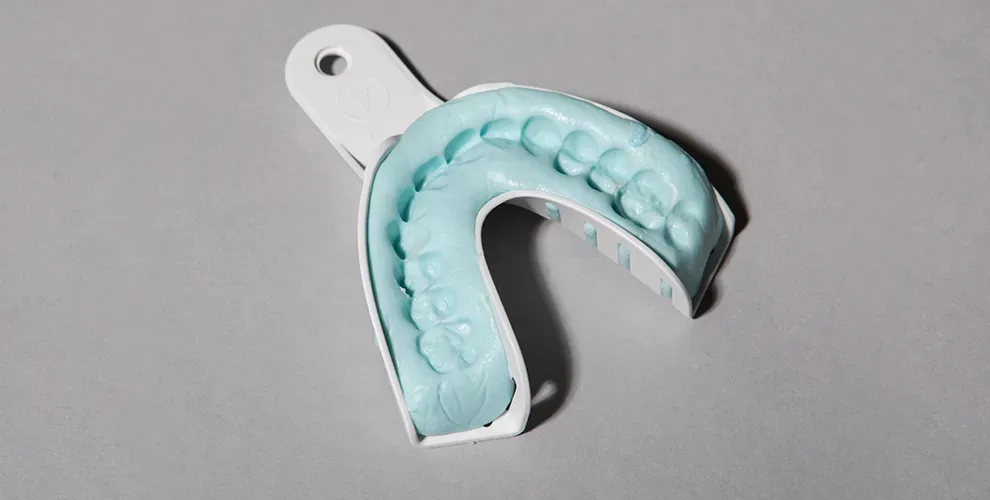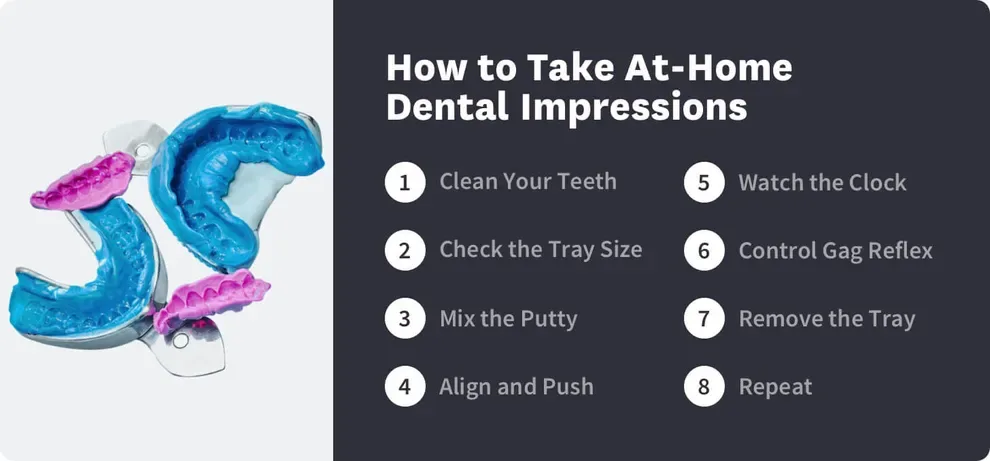A Guide to Perfect At-Home Dental Impressions.

Table of Contents
- Clean Your Teeth
- Check Tray Size
- Mix Your Putty
- Align and Push
- Watch the Clock
- Gag Reflex Control
- Remove Your Tray
- Repeat
Your path to a better smile begins with perfect impressions. Dental professionals use these imprints of your teeth to make aligners that fit your mouth. The better your impressions, the more likely it is that your aligners will sit on your teeth comfortably.
This step-by-step plan will help you create the models dental experts need. Read through the entire guide before you get started, as some steps are dependent on prior steps done right.

Step 1: clean your teeth.
Dentists say everyone should brush twice per day. Surveys suggest that about half of us only brush once per day. If you only brush once, do so right before you make your at-home dental impressions.
Food stuck in your teeth can move into your dental impressions. That could confuse the team making your aligners. Is that bump a tooth? A popcorn kernel? Your team won't know, and that could make your clear aligners less effective and perhaps less comfortable.
Prepare your teeth by:
Brushing for two minutes. Use a soft-bristle brush, and don't press too hard as you move the toothpaste around your teeth.
Flossing. Ensure that no tiny food particles sit between your teeth. Use floss between all of your teeth to reach every nook and cranny.
Rinsing. Use a mouthwash, and swirl it around your teeth. Tiny particles you dislodged with your work should go down the drain when you spit.
Step 2: check the tray size.
An at-home dental impression kit comes with several sets of trays. Two fit on your upper teeth, and two fit on the lower. You'll mail these plastic pieces back after they are filled with hardened putty.
You'll use one tray at a time, and while they may not feel comfortable inside your mouth, they should fit properly. The right tray will:
Cover your teeth. Pull your lips back, and you shouldn't see your teeth peeking out over the top of the plastic lip.
Feel roomy. The tray shouldn't touch or pinch your teeth when it's empty. You'll need room for the putty.
Fit well front to back. Your back teeth shouldn't hang out of the back end of the tray.
If your trays feel too small or too large, call the company before you get started with your impressions. You might need a new set sent to you before you begin.
Step 3: mix your putty.
Putty hardens around your teeth, but it shows up soft and pliant in your impression kit. Typically, you'll start the formal impression process by mixing two types of putty.
To complete this step:
Empty both types of putty into your hands. Scoop out the light putty and dark putty into the palm of your hand.
Squeeze them together. Mash the two colors together rigorously until the putty in your hands is one uniform color.
Watch the clock. Don't mash putty for longer than 30 seconds, or it will begin to harden.
Roll and fill. Push the putty between your hands until it's one log-like shape that you can press into one impression tray.
Step 4: align and push.
Your tray is filled with putty, and you're ready to showcase your pearly whites.
To finish this step:
Align. Find the center of the tray, and line up your center teeth with that space.
Push with your thumbs. Push your teeth into the tray until the putty covers your gumline. Stop before the bottom of your teeth hit the tray.
Center. Ensure that both sides of your teeth are pushed evenly into the putty.
Don't bite. You might be tempted to push down on the trays with the strength of your jaws. Resist the urge! Biting pushes your teeth to the bottom of the trays, and that makes your impressions less effective.
You don't have to be a dental expert to make perfect at-home impressions of your teeth. But you will need patience and precision to do the job right.
Step 5: watch the clock.
The putty should harden a bit before you remove your teeth, and that takes time. Remove the trays too early, and you won't have a firm impression. Leave the putty on too long, and it's hard to remove.
Set a timer for 3.5 minutes. That can seem like a long time. Researchers say, for example, that we grow irritated after 3.5 minutes on hold waiting for customer service. But remember that this is a crucial step toward a better smile. Patience is key.
Step 6: control your gag reflex.
Do your dental impressions the right way, and the putty will push against the top of your mouth and into the back of your throat. You might be tempted to gag or choke. Prepare for that and take action.
You can lower your gag reflex by:
Sitting up straight. Saliva won't run down the back of your throat if the top of your head is pointing at the ceiling.
Leaning forward. If you still feel as though you might gag, put your feet on the floor and tip your head toward the floor.
Controlling your breathing. Focus on breathing in through your nose on a count of 10.
Distracting your mind. Look out the window, or watch your cat play. Take your mind off your mouth, and the sensation might fade.
Step 7: remove your tray.
When your timer dings, it's time to take the trays away from your teeth. The putty will harden, so you might need to wiggle or tap the tray to loosen it. Then pull with gentle pressure to slide the materials away from your teeth.
Step 8: repeat.
You'll take four separate dental impressions of your teeth: two on the top, and two on the bottom. They'll get easier and easier each time.
You can do this!
